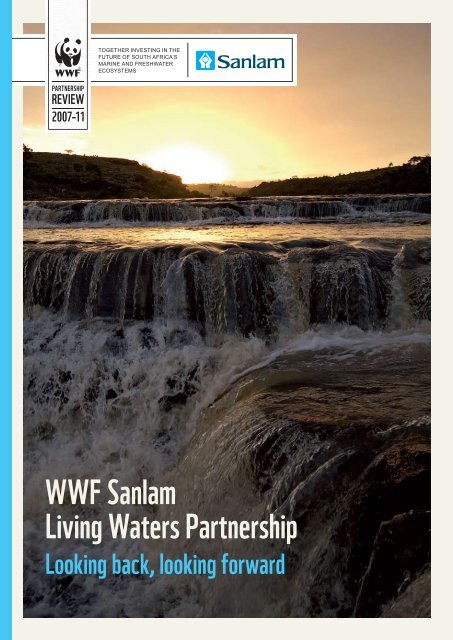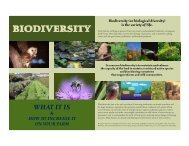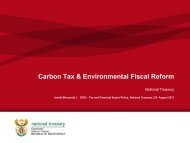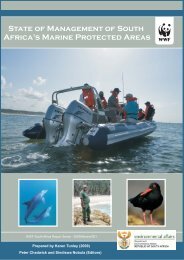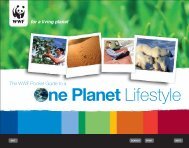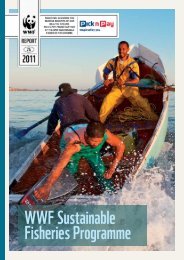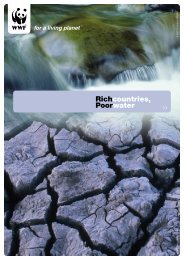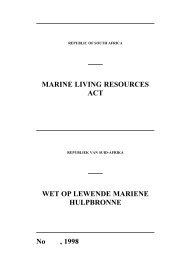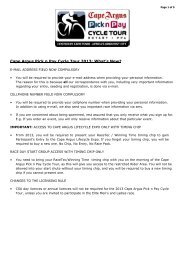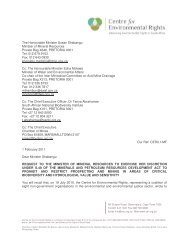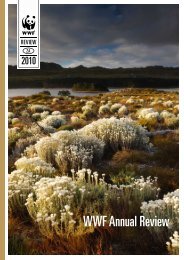WWF Sanlam Living Waters Partnership - WWF South Africa
WWF Sanlam Living Waters Partnership - WWF South Africa
WWF Sanlam Living Waters Partnership - WWF South Africa
Create successful ePaper yourself
Turn your PDF publications into a flip-book with our unique Google optimized e-Paper software.
TogeTher invesTing in The<br />
fuTure of souTh AfricA’s<br />
MArine And freshwATer<br />
ecosysTeMs<br />
<strong>WWF</strong> <strong>Sanlam</strong><br />
<strong>Living</strong> <strong>Waters</strong> <strong>Partnership</strong><br />
Looking back, looking forward
viSion oF the<br />
<strong>WWF</strong> SAnLAM<br />
LivinG WAteRS<br />
PARtneRShiP~<br />
Government, civil society and the private sector work<br />
together to build a future in which healthy aquatic<br />
ecosystems underpin the sustainable development<br />
of <strong>South</strong> <strong>Africa</strong> and enhance the quality of life of all<br />
its people.<br />
© PeTer chAdwick / wwf-sA
ContentS<br />
FoReWoRd 2<br />
<strong>WWF</strong>-SA CEO 2<br />
<strong>Sanlam</strong> CEO 3<br />
intRoduCtion 4<br />
Five yeARS oF the LivinG WAteRS PRoGRAMMe 6<br />
Key highlights: Freshwater and Marine 6<br />
Ten Reasons to celebrate 8<br />
Key LeSSonS LeARnt And WAy FoRWARd 18<br />
ACKnoWLedGeMentS 20<br />
<strong>WWF</strong> <strong>Sanlam</strong> <strong>Living</strong> <strong>Waters</strong> <strong>Partnership</strong> Five-year Review | page 1
FoReWoRd<br />
<strong>WWF</strong>-SA Ceo<br />
<strong>WWF</strong> <strong>Sanlam</strong> <strong>Living</strong> <strong>Waters</strong> <strong>Partnership</strong> Five-year Review | page 2<br />
The first five years of <strong>Partnership</strong> between <strong>WWF</strong><br />
<strong>South</strong> <strong>Africa</strong> and <strong>Sanlam</strong> in support of marine and<br />
freshwater conservation has served as a flag bearer for<br />
<strong>WWF</strong>’s deepening engagement with the private sector.<br />
This relationship is set to continue well into the future<br />
on this positive trajectory.<br />
The <strong>Partnership</strong> is truly deserving of the description<br />
of “pioneering” within the environmental sector since<br />
it has created a positive and constructive space for<br />
parties from different perspectives to meet to co-create solutions to some of the most<br />
important issues facing our society. These include food security (through our fisheries<br />
and agriculture work) and water security (through our freshwater programme).<br />
The <strong>Partnership</strong> has also become known for its innovative approaches to connecting<br />
our social and economic systems to the ecological systems that underpin them.<br />
Examples of this include the SASSI and Water Balance programmes.<br />
However, this <strong>Partnership</strong> has not only created change in the way society interacts<br />
with our aquatic resources, it has also been successful in stimulating and leading<br />
change within <strong>WWF</strong> <strong>South</strong> <strong>Africa</strong>. This partnership catalysed a shift from a reactive<br />
funding agency approach to a fresh new, proactive and strategic approach to freshwater<br />
and marine conservation within <strong>WWF</strong> <strong>South</strong> <strong>Africa</strong>.<br />
Despite the successes of the first phase, we cannot afford to rest on our laurels as<br />
there is still much that needs to be done. In many ways the successes of this first phase<br />
provide the platform for even greater success in the future. The state of our water and<br />
marine resources, remain under critical threat, with new pressures and challenges<br />
emerging. This is not unexpected in an emerging nation facing our particular<br />
development challenges.<br />
President Zuma’s recent State of the Nation address does, however, give cause for<br />
concern as it displays an unprecedented emphasis on the development of new large<br />
infrastructure.<br />
There is no doubt that hard engineering infrastructure development will play a critical<br />
role in our country’s future development. However, in my view, the nuance lies in how<br />
we will be able to merge hard engineering infrastructure development with the security<br />
and management of our ecological infrastructure that provides us with essential<br />
resources such as water, food and energy. This will provide a defining challenge for<br />
our nation.<br />
This challenge cannot be met by <strong>WWF</strong> alone and we will need to work closely with<br />
partners such as <strong>Sanlam</strong>. Importantly, the scale of this challenge will compel us to<br />
move beyond comfortable philanthropic partnerships to much closer integrative ones<br />
which will allow us to deliver sustainable benefits for both people and the environment.<br />
Morné du Plessis<br />
Chief Executive: <strong>WWF</strong> <strong>South</strong> <strong>Africa</strong>
FoReWoRd<br />
SAnLAM Ceo<br />
It is in our nature as wealth creators and protectors<br />
to consider the long-term effect of a good investment.<br />
We then work hard to ensure that the investment<br />
reward matches the expectations of our customers<br />
and shareholders. <strong>Sanlam</strong> has always done this by<br />
partnering with experts, using our own skills and<br />
muscle to strengthen the collective offering.<br />
It is with the same vigour that we approach the dangers<br />
of water scarcity and a world deprived of freshwater<br />
and marine resources. Our partnership with <strong>WWF</strong> is designed to identify practical<br />
and strategic steps that will mitigate the risk to a level that is measurable.<br />
While we aim to raise the bar in good practice for all to follow, our own barometer<br />
has been adjusted to enable even more internal changes to make every drop count.<br />
Over the first five years of this groundbreaking partnership, <strong>Sanlam</strong> has adopted<br />
stringent targets to help us set an example. By 2015 we will have reduced our own<br />
environmental footprint by 15%.<br />
One of the ways we hope to achieve this is by reducing our water consumption<br />
by 10%. Ironically, another way is to increase our use of freshwater significantly.<br />
By phasing out plastic bottled water, and relying on tap water instead, our staff<br />
will remain cool and fresh while not associated with the manufacturing and<br />
transportation impact of bottled water.<br />
By making waves in the ways other corporates consider their roles in water<br />
preservation in <strong>South</strong> <strong>Africa</strong>, we hope to cause a ripple effect for causes that<br />
share a goal. Indeed, government and other business partners are now adding<br />
their weight to projects like the Integrated Catchment Management Programme,<br />
the Wetlands Programme, the Sustainable Fisheries Programme and the Marine<br />
Protected Area programme.<br />
We are excited by the early returns of this investment that ultimately benefits all<br />
<strong>South</strong> <strong>Africa</strong>ns. Our extended commitment to another three years will further<br />
unlock the potential of water. It feeds the future through healthy crops and<br />
prosperous, well-nourished communities. By creating jobs, influencing positive<br />
policy decisions while introducing innovative ways to preserve water, the project<br />
feeds well into our sustainability efforts. If our water resources are at risk, our<br />
future hangs too close to the edge.<br />
We hope our involvement continues to set best practice standards and a wave of<br />
behavioural changes that culminate in a future filled with safer, healthy and usable<br />
freshwater and marine water resources.<br />
Johan van Zyl<br />
Chief Executive: <strong>Sanlam</strong><br />
<strong>WWF</strong> <strong>Sanlam</strong> <strong>Living</strong> <strong>Waters</strong> <strong>Partnership</strong> Five-year Review | page 3
A heALthy PLAnet<br />
enSuReS A heALthy<br />
FutuRe~<br />
“The environment and the economy are really both two<br />
sides of the same coin. You cannot sustain the economy<br />
if you don’t take care of the environment because<br />
we know that the resources that we use whether it is<br />
oil, energy, land…all of these are the basis in which<br />
development happens.”<br />
— Wangari Mathaai, Political & Environmental Activist<br />
and Nobel Prize Winner (1941-2011).<br />
© ThoMAs P. PeschAk
intRoduCtion<br />
The <strong>WWF</strong><br />
<strong>Sanlam</strong><br />
<strong>Living</strong> <strong>Waters</strong><br />
<strong>Partnership</strong><br />
has been<br />
described<br />
as a highly<br />
innovative,<br />
visionary and<br />
pioneering<br />
partnership.<br />
The wise management of our water<br />
resources and aquatic ecosystems<br />
is one of the most decisive factors<br />
that will affect the socio-economic<br />
development of <strong>South</strong> <strong>Africa</strong> and the well-being<br />
of the poorest sectors of our society over the next<br />
twenty years.<br />
At present usage rates, demand for freshwater will exceed supply by 2025, placing<br />
severe pressure on our freshwater ecosystems. Our inshore marine resources, which<br />
provide food and income to some of the poorest sectors of our society, are under<br />
similar levels of pressure. <strong>South</strong> <strong>Africa</strong>’s new democracy in 1994 allowed for the<br />
development of some of the most progressive and innovative freshwater and marine<br />
legislation in the world. However, the implementation of this legislation has proved<br />
challenging and simply cannot be successfully implemented by government alone.<br />
Only a cohesive and concerted effort from government, the private sector and civil<br />
society will ensure success.<br />
In response to this, <strong>WWF</strong> and <strong>Sanlam</strong> developed the <strong>Living</strong> <strong>Waters</strong> <strong>Partnership</strong>, with<br />
the vision of catalysing concerted action from government, the private sector and civil<br />
society around the wise management of our marine and freshwater resources.<br />
The <strong>WWF</strong> <strong>Sanlam</strong> <strong>Living</strong> <strong>Waters</strong> <strong>Partnership</strong>, incorporating <strong>WWF</strong> <strong>South</strong> <strong>Africa</strong>’s<br />
Marine and Freshwater Programmes, was officially launched in August 2007.<br />
Since its launch in 2007, the <strong>WWF</strong> <strong>Sanlam</strong> <strong>Living</strong> <strong>Waters</strong> <strong>Partnership</strong> has been<br />
described as a highly innovative, visionary and pioneering partnership that has<br />
catalysed many successful interventions in the <strong>South</strong> <strong>Africa</strong>n marine and freshwater<br />
conservation landscape.<br />
In addition to its core work in marine and freshwater conservation, the <strong>Partnership</strong><br />
also implemented a capacity development programme, the Leaders for <strong>Living</strong> <strong>Waters</strong><br />
Programme, which aimed to support the development of local individual champions<br />
within <strong>WWF</strong>’s aquatic conservation targets.<br />
Through the five years of the <strong>Partnership</strong>, the <strong>Living</strong> <strong>Waters</strong> <strong>Partnership</strong> was also<br />
very successful in developing a strong public profile on these important issues. The<br />
<strong>Partnership</strong> continues to be viewed as a source of balanced, rational and informed<br />
leadership on freshwater and marine management issues.<br />
Overall, the achievements of the <strong>WWF</strong> <strong>Sanlam</strong> <strong>Living</strong> <strong>Waters</strong> <strong>Partnership</strong> during its<br />
initial five year phase have positioned it very well as a significant player and investor in<br />
the management of <strong>South</strong> <strong>Africa</strong>’s aquatic resources. This report will highlight some of<br />
these achievements.<br />
<strong>WWF</strong> <strong>Sanlam</strong> <strong>Living</strong> <strong>Waters</strong> <strong>Partnership</strong> Five-year Review | page 5
5 yeARS oF the LivinG WAteRS PARtneRShiP –<br />
R67 MiLLion<br />
the PARtneRShiP WAS AbLe to LeveRAGe A totAL<br />
inveStMent oF R67 MiLLion FoR itS WoRK, oFF A CoRe<br />
inveStMent by SAnLAM oF R11.6 MiLLion 1 , ReSuLtinG<br />
in A LeveRAGe oF A FACtoR oF CLoSe to 6:1.<br />
2 300<br />
APPRoxiMAteLy 2 300 PeoPLe hAve been tRAined in<br />
the FReShWAteR And MARine SeCtoRS, in A nuMbeR<br />
oF initiAtiveS RAnGinG FRoM CAtChMent And<br />
MARine MAnAGeMent thRouGh to SuStAinAbLe<br />
SeAFood And ReSPonSibLe FiSheRieS.<br />
>330<br />
the PARtneRShiP CReAted MoRe thAn 330<br />
eMPLoyMent oPPoRtunitieS AS A ReSuLt oF<br />
<strong>WWF</strong>’S MARine And FReShWAteR initiAtiveS.<br />
120 000 heCtAReS<br />
<strong>WWF</strong> hAS inFLuenCed the deCLARAtion oF 120 000 heCtAReS<br />
oF MARine enviRonMent AS MARine PRoteCted AReAS.<br />
FuRtheRMoRe <strong>WWF</strong> hAS WoRKed With GoveRnMent to PioneeR<br />
one oF the LARGeSt MARine PRoteCted AReAS in the WoRLd<br />
(SoMe 18 MiLLion heCtAReS) ARound <strong>South</strong> AFRiCA’S PRinCe<br />
edWARd iSLAndS. thiS hAS been GAzetted by GoveRnMent<br />
AS An “intention to deCLARe” Within the next yeAR.<br />
SAvinG WAteR<br />
SuStAinAbLe SuGARCAne FARM MAnAGeMent SySteM (SuSFARMS),<br />
WhiCh WAS deveLoPed thRouGh thiS PARtneRShiP, hAS been AdoPted<br />
by the <strong>South</strong> AFRiCAn SuGAR ASSoCiAtion, With A CoMMitMent<br />
FoR CoMPLete RoLL out ACRoSS the induStRy. thiS CouLd See A<br />
SubStAntiAL iMPRoveMent in the PRACtiCeS oF one oF <strong>South</strong><br />
AFRiCA’S MoSt WAteR intenSive AGRiCuLtuRAL CRoPS.
SoMe Key StAtiStiCS<br />
>60%<br />
MoRe thAn 60% oF the <strong>South</strong> AFRiCAn SeAFood<br />
RetAiL MARKet hAS CoMMitted to SuPPoRtinG<br />
<strong>WWF</strong>’S SASSi PRoGRAMMe.<br />
AGentS oF ChAnGe<br />
the PARtneRShiP nuRtuRed A CRoP oF younG<br />
LeAdeRS FoR LivinG WAteRS Who ARe noW<br />
ACtive ‘AGentS oF ChAnGe’ in the MAnAGeMent<br />
oF <strong>South</strong> AFRiCA’S AquAtiC ReSouRCeS.<br />
±4,5 biLLion LitReS<br />
<strong>WWF</strong>’S WAteR bALAnCe PRoGRAMMe hAS SeCuRed A CoMMitMent FRoM<br />
LeAdinG <strong>South</strong> AFRiCAn CoRPoRAtionS LeAdinG to the RehAbiLitAtion oF<br />
1,500 heCtAReS oF CRitiCAL FReShWAteR hAbitAtS. thiS CoMMitMent WiLL<br />
ReSuLt in An eStiMAted AdditionAL 4, 5 biLLion LitReS oF FReShWAteR<br />
beinG SeCuRed eACh yeAR.<br />
unPReCedented PubLiC SuPPoRt<br />
<strong>WWF</strong>’S SASSi PRoGRAMMe hAS enjoyed unPReCedented PubLiC<br />
SuPPoRt GLobALLy, With MoRe thAn 650 000 inFoRMAtion WALLet<br />
CARdS diStRibuted And MoRe thAn 140 000 RequeStS beinG<br />
LodGed on ouR FiShMS SMS SeRviCe.<br />
>R60 MiLLion<br />
the PARtneRShiP enjoyed A PubLiC PRoFiLe to<br />
the vALue oF oveR R60 MiLLion oveR the Five<br />
yeARS (FRoM oveR 2 000 hitS).<br />
1 <strong>Sanlam</strong> contributed a total of R11.6 million over five years towards the core operational cost of the <strong>Living</strong> <strong>Waters</strong> Unit. An additional R3.6 million was invested<br />
directly into project spend. This brings the total amount invested by <strong>Sanlam</strong> over the five years of the partnership to R15.2 million.<br />
© clAudio velAsquez rojAs/hoMebrew filMs
Five yeARS oF the<br />
<strong>WWF</strong> SAnLAM LivinG<br />
WAteRS PARtneRShiP<br />
60%<br />
CuRRent<br />
<strong>South</strong> AFRiCAn<br />
RetAiL MARKet<br />
inFLuenCed by<br />
the <strong>WWF</strong> SASSi<br />
PRoGRAMMe<br />
Shark Spotters at Muizenberg beach<br />
<strong>WWF</strong> <strong>Sanlam</strong> <strong>Living</strong> <strong>Waters</strong> <strong>Partnership</strong> Five-year Review | page 8<br />
10 ReASonS to CeLebRAte<br />
A critical and independent review<br />
of the <strong>WWF</strong> and <strong>Sanlam</strong> <strong>Living</strong><br />
<strong>Waters</strong> <strong>Partnership</strong>, based on broad<br />
consultation with stakeholders,<br />
revealed the following ten reasons<br />
for this <strong>Partnership</strong> to celebrate:<br />
1. Innovative and catalytic<br />
The <strong>WWF</strong> <strong>Sanlam</strong> <strong>Living</strong> <strong>Waters</strong> <strong>Partnership</strong> has developed highly innovative and<br />
cutting edge creative solutions for conservation problems. Examples of these include:<br />
The SASSI campaign: this initiative has put sustainable seafood on the map,<br />
initially by driving change from the consumer end of the supply chain, and now with<br />
restaurants, retailers and the fishing industry. To this end, SASSI currently influences<br />
60% of the <strong>South</strong> <strong>Africa</strong>n seafood retail market.<br />
The Shark Spotters Programme: The <strong>WWF</strong> <strong>Sanlam</strong> <strong>Living</strong> <strong>Waters</strong> <strong>Partnership</strong><br />
catalysed the Shark Spotters project that employed spotters from the local community<br />
to reduce interactions between sharks and ocean users in the False Bay area.<br />
The <strong>WWF</strong> Water Balance Programme: This programme seeks to challenge and<br />
empower corporate <strong>South</strong> <strong>Africa</strong> to help create a water secure future by reducing demand,<br />
increasing supply and maintaining the health of our high water provisioning catchments.<br />
© wwf-sA
Founded on a<br />
fundamental<br />
relationship<br />
with <strong>Sanlam</strong>, the<br />
<strong>Living</strong> <strong>Waters</strong><br />
<strong>Partnership</strong> has<br />
been able to use<br />
this foundation<br />
to demonstrate<br />
successes on<br />
the ground and<br />
build confidence<br />
for further<br />
partners to<br />
invest.<br />
Sustainable Sugar Initiative: The development and implementation of<br />
SuSFarMS guidelines for managing sugar farms had the important impact of<br />
supporting a move to more sustainable farming practices. Additionally, SuSFarMS<br />
has also had broader catalytic impact in terms of being a precursor to the Good<br />
Farming Guidelines promoted by GreenChoice and taken up more broadly by<br />
number of agricultural industries.<br />
2. Negotiating Solutions<br />
The <strong>Partnership</strong> has become highly respected for its facilitatory and solutionsoriented<br />
approach as well as for its convening power to bring together stakeholders<br />
with differing perspectives with the common aim of finding solutions that can be<br />
broadly supported. Examples of this include:<br />
The Business and Water Risk round tables: the <strong>WWF</strong> Integrated Catchment<br />
Management Programme convened a series of national water dialogues between the<br />
private and public sector to make the business case for water as a shared risk. The<br />
outcomes of these sessions were presented at the UN CEO Water Mandate working<br />
conference which was held in <strong>South</strong> <strong>Africa</strong> in November 2010.<br />
The Responsible Fisheries Alliance: <strong>WWF</strong> <strong>South</strong> <strong>Africa</strong>, together with four<br />
major fishing industry players, namely I&J, Oceana, Sea Harvest and Viking,<br />
launched the Responsible Fisheries Alliance (RFA). This is the first alliance of its<br />
kind in the history of <strong>South</strong> <strong>Africa</strong>n marine conservation. The Alliance is a bid to<br />
achieve the common goal of ensuring that all stakeholders understand and support<br />
the implementation of an Ecosystem Approach to Fisheries (EAF) management in<br />
<strong>South</strong> <strong>Africa</strong>’s fisheries.<br />
The Marine Protected Areas Forum: This annual forum, first convened in<br />
2007, brings together stakeholders involved in marine conservation, in particular<br />
MPAs, to address and develop solutions around the threats and pressures facing<br />
our marine environment. The forum currently boasts more than 100 members<br />
representing six <strong>Africa</strong>n countries.<br />
3. Credible<br />
The <strong>WWF</strong> <strong>Sanlam</strong> <strong>Living</strong> <strong>Waters</strong> <strong>Partnership</strong> has over the past five years, become<br />
respected for its scientific and rational stance. This is evident from the strong<br />
alliances that the <strong>Partnership</strong> has with government, the private sector, academia and<br />
other civil society groups.<br />
Founded on a fundamental relationship with <strong>Sanlam</strong>, the <strong>Living</strong> <strong>Waters</strong> <strong>Partnership</strong><br />
has been able to use this foundation to demonstrate successes on the ground and<br />
build confidence for further partners to invest. The <strong>Partnership</strong> now enjoys support<br />
from four primary partners: Mondi, Pick n Pay, Honda and De Beers. Importantly, all<br />
these partnerships now extend beyond pure philanthropic relationships, and include<br />
joint work on sustainability and communications.<br />
The marine programmes have played a very active role in influencing policy and<br />
opinion. One of the key contributions to this objective has been <strong>WWF</strong>’s comment on the<br />
proposed opening of the Tsitsikamma MPA in 2007 and then again in 2010. Furthermore,<br />
in 2008 <strong>WWF</strong> utilised an international marine conference held in Cape Town to<br />
develop a strong public lobby for the declaration of the Prince Edward Islands MPA.<br />
<strong>WWF</strong> has also launched several reports related to implementing an Ecosystem<br />
Approach to Fisheries (EAF), in particular Ecological Risk Assessments, which<br />
<strong>WWF</strong> <strong>Sanlam</strong> <strong>Living</strong> <strong>Waters</strong> <strong>Partnership</strong> Five-year Review | page 9
<strong>Africa</strong>n black oystercatchers in a marine protected area.<br />
<strong>WWF</strong> <strong>Sanlam</strong> <strong>Living</strong> <strong>Waters</strong> <strong>Partnership</strong> Five-year Review | page 10<br />
© clAudio velAsquez rojAs/hoMebrew filMs
The <strong>Living</strong><br />
<strong>Waters</strong><br />
<strong>Partnership</strong><br />
created a<br />
significant<br />
media profile<br />
around the<br />
water crisis in<br />
<strong>South</strong> <strong>Africa</strong>.<br />
were an important stepping stone for the implementation of this holistic approach<br />
to fisheries management. With regards to freshwater issues, the <strong>Living</strong> <strong>Waters</strong><br />
<strong>Partnership</strong> created a significant media profile around the water crisis in<br />
<strong>South</strong> <strong>Africa</strong> in 2008 and was a leading voice in the desalination debate in 2010.<br />
The <strong>Partnership</strong>’s relationship with relevant government departments has also<br />
grown significantly since its inception. Both parties (<strong>WWF</strong> and government) are<br />
starting to understand the role of <strong>WWF</strong> as a supporter and co-implementer of<br />
projects, as well as ensuring oversight and accountability. These two roles add<br />
much to engendering good governance.<br />
4. Enabling people to create change<br />
From the onset, the <strong>WWF</strong> <strong>Sanlam</strong> <strong>Living</strong> <strong>Waters</strong> <strong>Partnership</strong> acknowledged that it<br />
could never achieve the level of influence and change that it would like to through its<br />
efforts and resources alone. As such, the <strong>Partnership</strong> identified that one of the best<br />
uses of its resources was through empowering others with skills and knowledge, and<br />
to provide the environment in which they can create change.<br />
The application of a few key principles of modern education theory has allowed the<br />
<strong>Partnership</strong> to create change at several levels, over and above the pure transfer of<br />
knowledge. A few examples illustrate this:<br />
Developing teams or ‘communities-of-practice’, amongst a broad range of<br />
stakeholders that should be working together but do not understand each other’s<br />
roles, responsibilities and perspectives or communicate effectively. A good example<br />
of this has been the <strong>WWF</strong> Responsible Fisheries training course, which brings<br />
together skippers of fishing vessels, fisheries managers and observers as well<br />
as compliance officers, to develop a common understanding of the challenge of<br />
implementing an Ecosystem Approach to Fisheries.<br />
Similarly, the <strong>Partnership</strong>’s catchment management training brings together<br />
local Water User Associations, community representatives, water managers and<br />
municipal employees to develop a common understanding of the ecological and<br />
management aspects of implementing Integrated Water Resource Management.<br />
5. Far-reaching influence<br />
The <strong>Partnership</strong> has developed some key initiatives that have had national, regional<br />
and international influence.<br />
For example, in 2008 the Namibian Cabinet approved a submission to declare<br />
Namibia’s first MPA, stretching some 120 000 hectares from Meob Bay to Chamais<br />
Bay. This came after sustained efforts by <strong>WWF</strong> in first undertaking a legal review,<br />
leading stakeholder discussions to develop a plan that enjoyed majority support, and<br />
finally developing the detailed documentation for submission to cabinet.<br />
Similarly in 2009, the then Minister of Environmental Affairs, Marthinus van<br />
Schalkwyk, announced his intention to declare the world’s fourth largest MPA<br />
around <strong>South</strong> <strong>Africa</strong>’s Prince Edward Islands. The islands are located almost 2<br />
000km south off our coast in the <strong>South</strong>ern Ocean, and form an important global<br />
biodiversity hotspot. This announcement came almost five years after Minister van<br />
Schalkwyk initially announced his intention to declare the MPA. <strong>WWF</strong> worked<br />
closely with the then Department of Environmental Affairs and Tourism to complete<br />
a thorough planning and stakeholder consultation process. Financing for much of<br />
this planning was obtained from <strong>Sanlam</strong> and the Charl van der Merwe Trust.<br />
<strong>WWF</strong> <strong>Sanlam</strong> <strong>Living</strong> <strong>Waters</strong> <strong>Partnership</strong> Five-year Review | page 11
The Water<br />
Futures<br />
<strong>Partnership</strong><br />
seeks to<br />
demonstrate<br />
how leading<br />
global<br />
companies<br />
can get involved<br />
in catchment<br />
management.<br />
On the freshwater front, <strong>WWF</strong> <strong>South</strong> <strong>Africa</strong> is involved at an international level with<br />
SABMiller and the Deutsche Gesellschaft für Internationale Zusammenarbeit (GIZ) on<br />
a Water Futures <strong>Partnership</strong>. The aim of this alliance is to implement sustainable water<br />
management and poverty alleviation initiatives in catchments on which the brewery<br />
is dependent. This alliance will demonstrate, for the first time, how a leading global<br />
company can use innovative water footprint and water risk tools and contribute to<br />
improved catchment management public dialogues around water.<br />
<strong>WWF</strong> <strong>South</strong> <strong>Africa</strong> together with <strong>WWF</strong> Netherlands and the <strong>WWF</strong> East <strong>Africa</strong> office<br />
is working in the trans-boundary Zambezi basin in partnership with the Netherlands<br />
government and key stakeholders in the region. <strong>WWF</strong>-SA is leading the component<br />
of the project that defines Freshwater Resource Areas critical to maintaining<br />
environmental flows through the basin and its biodiversity. The Freshwater Resource<br />
Areas in the entire Zambezi River Basin to date have not been well understood; this<br />
assessment will provide a good understanding at a landscape level of the dynamics that<br />
contribute to sustaining environmental flows on the Zambezi River. <strong>WWF</strong>-SA is also<br />
working in partnership with the CSIR and the Peace Parks Foundation in this work.<br />
6. Creating employment opportunities<br />
A total of 332 people were provided with employment from various <strong>Living</strong> <strong>Waters</strong><br />
<strong>Partnership</strong>’s projects since 2008. Examples of employment opportunities<br />
created include:<br />
a. Innovative programmes such as the bird-scaring line construction with the Ocean<br />
View Association for Persons with Disabilities have had enormous social benefit to a<br />
marginalised group.<br />
Making tori-lines at the Ocean View Association for People with Disabilities; the tori line team.<br />
<strong>WWF</strong> <strong>Sanlam</strong> <strong>Living</strong> <strong>Waters</strong> <strong>Partnership</strong> Five-year Review | page 12<br />
© roger sedres (coMMissioned by wwf-sA)
. Alien clearing for the Water Balance Programme.<br />
c. <strong>WWF</strong> also catalysed the Shark Spotters programme, an early warning system to<br />
prevent shark attack and reduce shark-human conflict. Today this programme<br />
employs 14 people.<br />
d. Successful candidates from the Marine guide training course have been employed.<br />
7. Creating a new skills paradigm for the better management of our<br />
aquatic resources<br />
A total of 2 248 people have been trained as a result of the <strong>Partnership</strong>’s marine and<br />
freshwater work over the past five years. Examples include:<br />
a The Marine Protected Areas, Responsible Fisheries and Catchment Management<br />
Agency training courses have all contributed towards building the capacity of our<br />
aquatic stewards.<br />
b The Leaders for <strong>Living</strong> <strong>Waters</strong> Programme identified, nurtured and supported<br />
17 young individuals to gain skills and pursue careers in the aquatic<br />
conservation sector.<br />
c The <strong>Living</strong> <strong>Waters</strong> <strong>Partnership</strong> has supported staff growth and six postgraduate<br />
degrees have been earned with the support of <strong>WWF</strong>.<br />
Leaders for <strong>Living</strong> <strong>Waters</strong><br />
one of the major challenges facing environmental management in south <strong>Africa</strong> is the<br />
development of the next tranche of environmental leaders with the appropriate skills,<br />
knowledge and motivation to capitalise on the significant opportunities provided by a<br />
country blessed with rich natural capital and very progressive environmental policies<br />
and legislation.<br />
in response to this challenge, wwf and sanlam dedicated funds to assist in the<br />
development of the next tier of leaders in the conservation of our aquatic resources<br />
through the wwf sanlam leaders for living waters Programme.<br />
The vision of the leaders for living waters Programme was to assist in developing a<br />
new tier of leaders and champions for the wise management of our aquatic resources.<br />
The programme seeks to employ a highly selective and targeted individual approach to<br />
give effect to this vision.<br />
The programme targeted and developed leaders within key conservation partner<br />
agencies, the wwf sanlam living waters <strong>Partnership</strong> programmatic structures and at<br />
a local community level in association with our site-based projects.<br />
The programme will seek to develop leadership and skills through the following<br />
interventions:<br />
• Training: Developing knowledge and skills by providing financial support and<br />
guidance for training, and supporting the development of relevant and appropriate<br />
training opportunities<br />
• Work experience: developing practical working experience through internship<br />
programmes (both within partner structures and within <strong>WWF</strong>)<br />
• Career planning: Providing assistance with career planning and development<br />
• Broadening experiential understanding: Through interchange visits and<br />
secondments<br />
Since the establishment of the programme in 2008, 17 young individuals have<br />
benefited through the abovementioned interventions.<br />
<strong>WWF</strong> <strong>Sanlam</strong> <strong>Living</strong> <strong>Waters</strong> <strong>Partnership</strong> Five-year Review | page 13
R60 MiLLion<br />
totAL AdveRtiSinG<br />
vALue equivALent oF<br />
the PARtneRShiP’S<br />
MediA PRoFiLe oveR<br />
the Five yeARS.<br />
8. Creating public awareness and mobilising support<br />
<strong>WWF</strong> has raised the public profile of the importance of aquatic conservation in <strong>South</strong><br />
<strong>Africa</strong> with an approximate total average Advertising Value Equivalent of R60 million<br />
over the five years of the <strong>Partnership</strong>. The <strong>Partnership</strong>’s communication and media<br />
efforts achieved two key outcomes, namely: (1) Positioning the strategic importance of<br />
water at the centre of the economic development debate, and (2) mobilising the public<br />
into a powerful collective to engage in marine management issues.<br />
Highlights around the first outcome include:<br />
The launching of the <strong>WWF</strong> Blueprint Report In 2009. The Blueprint (prepared with<br />
assistance from Pegasys Strategy and Development), outlines 10 key action areas for<br />
government, the private sector and civil society to ensure that healthy freshwater<br />
ecosystems continue to underpin economic and social well-being in <strong>South</strong> <strong>Africa</strong>.<br />
The ‘Business of Water Series’ with the Business Report which ran during 2009/10<br />
was aimed at creating a greater awareness of the water challenge facing <strong>South</strong> <strong>Africa</strong><br />
and also mobilising the private sector and civil society to become responsible stewards<br />
of our scarce and threatened freshwater resources. This entailed putting together a<br />
team of experts in the <strong>South</strong> <strong>Africa</strong>n freshwater sector to write a series of well-planned<br />
articles and opinion pieces themed ‘The Business of Water’ which were published in<br />
the Business Report every month for 11 months. This set of articles was based on the<br />
10 key areas of action that were outlined in the <strong>WWF</strong> Water Blueprint. The series was<br />
well received by the public and was lauded as a success.<br />
The acceptance of the late Professor Kader Asmal, former Minister of Water Affairs<br />
and Forestry, to serve as a Patron of the Water Balance Programme when it was first<br />
launched in 2008, did much to raise the profile of this important body of work and also<br />
highlight the seriousness of <strong>South</strong> <strong>Africa</strong>’s water situation (see figure 1).<br />
<strong>WWF</strong> was also a leading voice in the desalination debate that gained prominence in<br />
the first half of 2010.<br />
In terms of mobilising the public to play a more active role in the management of<br />
<strong>South</strong> <strong>Africa</strong>’s marine resources and ensuring a more sustainable seafood industry,<br />
the clearest case of this has been the <strong>WWF</strong> SASSI programme. Before the launch of<br />
SASSI in 2005, the sustainability of <strong>South</strong> <strong>Africa</strong>n seafood stocks was not high in the<br />
consciousness of the average <strong>South</strong> <strong>Africa</strong>n. Fast forward to the present, following<br />
active promotion of the programme in the media and other platforms, SASSI has now<br />
taken on a public profile life of its own. The media, the hospitality industry, seafood<br />
traders and other conservation organisations seem to be adopting the SASSI advice<br />
and guidelines as standard ‘better practice’ and are promoting it of their own accord.<br />
Additionally, when the programme first started there were very few, if any, retailers<br />
in <strong>South</strong> <strong>Africa</strong> that had taken any kind of stand on sustainable seafood procurement<br />
practices. Spurred on by the rapid growth in consumer awareness around the issue,<br />
the <strong>South</strong> <strong>Africa</strong>n seafood industry has now come to realise that sustainability issues<br />
are important to their customers and their business. There is now an ever-growing<br />
demand on the <strong>WWF</strong> Sustainable Fisheries team to engage with the industry on<br />
these issues.<br />
9. Driving change across the value chain<br />
Price and quality are traditionally the determinants of decisions about how goods are<br />
traded across the value chain. However, more recently, ethical considerations (social<br />
and environmental) are increasingly important as decision-making criteria. The <strong>Living</strong><br />
<strong>Waters</strong> <strong>Partnership</strong> has been successful in increasing the importance of environmental<br />
<strong>WWF</strong> <strong>Sanlam</strong> <strong>Living</strong> <strong>Waters</strong> <strong>Partnership</strong> Five-year Review | page 14
Figure 1: This article, written by the late Professor Kader Asmal, appeared in Business Day on Monday, 17 November 2008.<br />
<strong>WWF</strong> <strong>Sanlam</strong> <strong>Living</strong> <strong>Waters</strong> <strong>Partnership</strong> Five-year Review | page 15
The <strong>WWF</strong> <strong>Sanlam</strong> <strong>Living</strong> <strong>Waters</strong> <strong>Partnership</strong>, in collaboration with GreenChoice, initiated the development of<br />
the <strong>WWF</strong> <strong>Living</strong> Farms Reference framework, a guideline for sustainable farming in <strong>South</strong> <strong>Africa</strong>.<br />
<strong>WWF</strong> <strong>Sanlam</strong> <strong>Living</strong> <strong>Waters</strong> <strong>Partnership</strong> Five-year Review | page 16<br />
© PeTer chAdwick / wwf-sA
The <strong>WWF</strong><br />
Sustainable<br />
Fisheries<br />
Programme<br />
has been very<br />
successful in<br />
orchestrating<br />
change across<br />
the seafood<br />
supply chain.<br />
consideration across the value chain, as well as with assisting producers, processors,<br />
wholesalers and retailers to respond to this new imperative.<br />
For instance, the <strong>WWF</strong> Sustainable Fisheries Programme has been very successful<br />
in orchestrating change across the seafood supply chain, working directly with<br />
seafood consumers to increase awareness and empower collective action, to working<br />
with seafood suppliers, retailers and restaurants to improve procurement practices,<br />
through to working directly with the fishing industry to improve fishing practices.<br />
Another example is the Sustainable Sugarcane Farm Management System<br />
(SuSFarMS) which originally developed in partnership between <strong>WWF</strong>, WESSA<br />
and a group of forward thinking farmers in the Noodsberg area in KwaZulu-Natal.<br />
This programme has made significant strides codifying best agricultural practices<br />
in this industry and working across the entire industry to get this farm management<br />
system endorsed and supported by the <strong>South</strong> <strong>Africa</strong>n Sugar Association for roll<br />
out across the entire industry. On the other end of the supply chain <strong>WWF</strong> has been<br />
working with large international buyers of sugar, such as The Coca-Cola Company,<br />
to create the market pull for the entrenchment of these practices. Recently, <strong>WWF</strong><br />
facilitated a meeting between the largest global sugar buyers (including Coke, Kraft<br />
and Unilever) and the <strong>South</strong> <strong>Africa</strong>n sugar industry, in which these buyers conveyed<br />
their commitment towards SuSFarMS as an effective tool for helping them meet their<br />
commitments to the responsible procurement of sugar.<br />
Flowing from the work on developing the Sustainable Sugar Farm Management<br />
System, the <strong>WWF</strong> <strong>Sanlam</strong> <strong>Living</strong> <strong>Waters</strong> <strong>Partnership</strong> initiated the development of<br />
the <strong>WWF</strong> <strong>Living</strong> Farms Reference framework, a guideline for sustainable farming<br />
in <strong>South</strong> <strong>Africa</strong>. This framework, developed in collaboration with GreenChoice, a<br />
conservation sector initiative created to support sustainable agriculture practices<br />
in <strong>South</strong> <strong>Africa</strong>, is the first of its kind in the country and now underpins <strong>WWF</strong>’s<br />
engagements with the <strong>South</strong> <strong>Africa</strong>n agricultural sector. It has also led to the<br />
development of numerous sectoral codes of best agricultural practices, including<br />
mohair, barley, wine and sustainable fruit.<br />
10. This partnership changed the way <strong>WWF</strong> <strong>South</strong> <strong>Africa</strong> did its business<br />
This pioneering <strong>Partnership</strong> was a significant milestone for <strong>WWF</strong> <strong>South</strong> <strong>Africa</strong> as<br />
it shifted the organisation from a reactive funding agency to a proactive, strategic<br />
organisation working at the cutting edge of freshwater and marine conservation in<br />
<strong>South</strong> <strong>Africa</strong>.<br />
<strong>WWF</strong> <strong>Sanlam</strong> <strong>Living</strong> <strong>Waters</strong> <strong>Partnership</strong> Five-year Review | page 17
Key LeSSonS LeARned<br />
And the WAy FoWARd<br />
The freshwater<br />
programme<br />
has been very<br />
successful in<br />
helping build<br />
the economic<br />
and business<br />
case for water<br />
as a key<br />
constraint<br />
or enabler of<br />
growth and<br />
prosperity for<br />
our nation.<br />
Without doubt, the <strong>Partnership</strong><br />
between <strong>WWF</strong> and <strong>Sanlam</strong> has<br />
been a highly successful one.<br />
The <strong>Partnership</strong> has not only been<br />
successful in delivering significant<br />
conservation impact, but has also delivered a very strong<br />
institutional foundation and innovative approach upon<br />
which to build.<br />
The <strong>Partnership</strong> has earned a reputation as a facilitator, innovator and catalyser of<br />
collaborative action; all based on credible, scientific and solutions-based approaches.<br />
This has come within a testing institutional and policy environment. During this<br />
reporting period the national Department of Water Affairs experienced extreme<br />
instability in its leadership, whilst the national Department of Environmental<br />
Affairs and Tourism (Branch: Marine & Coastal Management) was split across two<br />
new departments. This lack of continuity, as well as challenges related to policy<br />
implementation, severely affected the ability of the <strong>Partnership</strong> to work more closely<br />
with government.<br />
Nevertheless, the partnership saw significant growth during this five year period, being<br />
successful in leveraging more than R67 million in project activity off the back of the<br />
R11,6 million rand that <strong>Sanlam</strong> invested in its core operations over the first five years.<br />
As with any business, success and growth provide a unique set of challenges. The<br />
challenge for the <strong>Partnership</strong> going forward will be to build on the sound foundation<br />
that has already been set and to refine its approach to deliver significant gains.<br />
The freshwater programme has been very successful in helping build the economic<br />
and business case for water as a key constraint or enabler of growth and prosperity<br />
for our nation. This has resulted in a number of large corporations seeking to better<br />
understand their water risks and potential responses. The challenge for the <strong>WWF</strong> and<br />
<strong>Sanlam</strong> <strong>Partnership</strong> going forward will be to build on this heightened awareness and<br />
motive, to provide clearer pathways of change to a more water resilient nation and<br />
economy. This needs to happen at three levels.<br />
Firstly, the <strong>Partnership</strong> will need work closely with the central planning functions in<br />
government to drive home the integrated and interconnected nature of water and water<br />
planning to our sustainable development in a very practical way. Here the National<br />
Planning Commission is a logical start. However, the <strong>Partnership</strong> will seek to illustrate<br />
its point through practical and urgent examples such as the apparent uninhibited<br />
expansion of coal mining in the headwaters of some our country’s most important<br />
rainfall catchments, placing these important sources of water at risk. Secondly, the<br />
<strong>Partnership</strong> will need to work with the private sector in a very practical way to help<br />
them understand how they can become better stewards of the precious water resources<br />
that underpin their businesses (and associated economic and social benefits, such as<br />
jobs). Finally, the <strong>Partnership</strong> needs to mobilise ordinary <strong>South</strong> <strong>Africa</strong>ns to contribute<br />
in a meaningful way to this issue, which affects us all.<br />
The marine programme on the other hand, has been very successful over the past<br />
years at developing a structure that mobilises action across the fisheries supply chain.<br />
This has been a monumental effort that deserves the tribute it receives. However,<br />
the challenge going forward will be to see how the <strong>Partnership</strong> utilises this structure<br />
to continue driving real change! The next phase of this <strong>Partnership</strong> will therefore<br />
focus on channelling action towards improving the status of key marine resources.<br />
<strong>WWF</strong> <strong>Sanlam</strong> <strong>Living</strong> <strong>Waters</strong> <strong>Partnership</strong> Five-year Review | page 18
The first phase of the <strong>Partnership</strong> also saw significant gains in the management of<br />
inshore Marine Protected Areas; however, these protected areas have not always<br />
enjoyed the optimal support of surrounding communities. The next phase of the<br />
partnership will need to ensure that these Marine Protected Areas are located<br />
within a broader framework that caters more adequately for multiple interests of<br />
surrounding communities and hence enjoys their support. A further challenge will<br />
be to take the gains made in inshore Marine Protected Areas to key marine habitats<br />
located further offshore.<br />
Finally, the first phase of the <strong>WWF</strong> and <strong>Sanlam</strong> <strong>Partnership</strong> saw significant<br />
sustainability gains within <strong>Sanlam</strong>. Over this phase of the partnership <strong>Sanlam</strong> has<br />
set consumption reductions targets for the period 2011 – 2015. These targets are<br />
aimed at reducing the Group’s carbon footprint by 15%, and include a 20% reduction<br />
in electricity use and a reduction of water consumption by 10%. The next phase of the<br />
<strong>Partnership</strong> needs to focus on moving beyond operational sustainability to a more<br />
complete understanding how <strong>Sanlam</strong> can use its leverage as one of <strong>South</strong> <strong>Africa</strong>’s<br />
leading corporations to drive change on environmental issues, with a particular<br />
focus on water.<br />
<strong>WWF</strong> <strong>Sanlam</strong> <strong>Living</strong> <strong>Waters</strong> <strong>Partnership</strong> Five-year Review | page 19<br />
© clAudio velAsquez rojAs/hoMebrew filMs
LiSt oF FundeRS,<br />
SuPPoRteRS And<br />
CoLLAboRAtoRS<br />
Anchor Consulting<br />
Anglo American’s Fund<br />
Benguela Current Large Marine<br />
Ecosystem (BCLME)<br />
Business Report<br />
Cape Action Plan for People and the<br />
Environment (C.A.P.E.)<br />
CapeNature<br />
Cassia @ Nitida Wine Farm<br />
CaterPlus (Bidvest)<br />
Charl van der Merwe Trust<br />
City of Cape Town<br />
Coastal Management<br />
Council for Scientific and Industrial<br />
Research (CSIR)<br />
De Beers Consolidated Group<br />
De Beers Marine<br />
Department of Environmental<br />
Affairs – Oceans & Coasts<br />
Department of Water Affairs<br />
Department of Water Affairs:<br />
Working for Water<br />
Department of Water Affairs:<br />
Working in Wetlands<br />
Deutsche Gesellschaft für<br />
Internationale Zusammenarbeit<br />
(GIZ)<br />
DUCT: The Duzi-uMngeni<br />
Conservation Trust<br />
Dyer Island Cruises<br />
Endangered Wildlife Trust (EWT)<br />
Ezemvelo Kwazulu Natal Wildlife<br />
Falcon Inflatables<br />
Field Guides Association of <strong>South</strong>ern<br />
<strong>Africa</strong> (FGASA)<br />
Fresh Tuna Export Association<br />
G Raimondo Charitable Trust<br />
Gamtoos Irrigation Board<br />
Garmin<br />
Global Environmental Facility<br />
Green Connections<br />
Grindrod<br />
Hacker Bequest<br />
Heine Bequest<br />
Hetherington Consulting<br />
Honda<br />
Honda Marine<br />
Incofish<br />
Irvin & Johnson (I&J)<br />
Iveri Payment Technology<br />
John Dory’s Fish & Grill<br />
KEAG: Kommetjie Environmental<br />
Action Group<br />
MACS Shipping<br />
Mazda Wildlife Fund<br />
Mondi Ltd.<br />
NACOMA<br />
Namibian Coast Conservation and<br />
Management Project<br />
Naspers<br />
National Lottery Board<br />
The <strong>WWF</strong> Nedbank Green Trust<br />
Noodsberg Canegrowers Association<br />
Ocean Basket<br />
Ocean Brand Ltd<br />
Oceanfresh Seafoods Ltd<br />
ORCA<br />
Pegasys Strategy and Development<br />
Petroleum <strong>South</strong> <strong>Africa</strong><br />
PGW-Eat<br />
Pick n Pay<br />
Rand Merchant Bank<br />
Rand Merchant Bank Fund<br />
Rhodes University<br />
Rowland and Leta Hill Trust<br />
<strong>Sanlam</strong><br />
SASSI Supporting Restaurants<br />
Sea Harvest<br />
Sea World at uShaka<br />
Sharklife<br />
<strong>South</strong> <strong>Africa</strong>n Breweries Ltd.<br />
<strong>South</strong> <strong>Africa</strong>n Institute for Aquatic<br />
Biodiversity (SAIAB)<br />
<strong>South</strong> <strong>Africa</strong>n National Biodiversity<br />
Institute (SANBI)<br />
<strong>South</strong> <strong>Africa</strong>n National Parks<br />
(SANParks)<br />
<strong>South</strong> <strong>Africa</strong>n Sugar Association<br />
<strong>WWF</strong> <strong>Sanlam</strong> <strong>Living</strong> <strong>Waters</strong> <strong>Partnership</strong> Five-year Review | page 20<br />
The <strong>WWF</strong> <strong>Living</strong> <strong>Waters</strong> <strong>Partnership</strong><br />
would like to extend a warm thank<br />
you to all its funders, supporters<br />
and collaborators from over the last<br />
five years in government, the private<br />
sector, academia and other NGOs.<br />
Spar<br />
Terrapi<br />
The Better Sugarcane Initiative<br />
Limited<br />
The Royal Netherlands Embassy,<br />
Maputo<br />
The Table Mountain Fund<br />
Thomas Peschak – Currents of<br />
Contrast Productions<br />
Tony & Lisette Lewis Foundation<br />
Total Foundation<br />
TRAFFIC<br />
Two Oceans Aquarium<br />
uMsenge: Conservation,<br />
Environment and Development<br />
University of Cape Town<br />
Viking Fisheries<br />
Water Matters<br />
Wildlife and Environment Society of<br />
<strong>South</strong> <strong>Africa</strong> (WESSA)<br />
Woolworths<br />
Working for Wetlands<br />
<strong>WWF</strong> Australia<br />
<strong>WWF</strong> International<br />
<strong>WWF</strong> Netherlands<br />
<strong>WWF</strong> United Kingdom<br />
<strong>WWF</strong> United States<br />
<strong>WWF</strong> United States – Sustainable<br />
Fisheries Fund<br />
Yalo Sifiso
Editorial team: Sindiswa Nobula, Deon Nel and Eitan Prince<br />
www.wwf.org.za<br />
Design and Layout: Jenny Frost Design<br />
Front cover photo: © Claudio Velasquez Rojas/Homebrew films<br />
Printed by DEEP<br />
This report is printed on Reviva Plus, a 100% recycled paper.<br />
Published in April 2012 by <strong>WWF</strong>-World Wide Fund For Nature<br />
(Formerly World Wildlife Fund), Cape Town, <strong>South</strong> <strong>Africa</strong>.<br />
Any reproduction in full or in part must mention the title and<br />
credit the above-mentioned publisher as the copyright owner.<br />
© Text 2012 <strong>WWF</strong>-SA<br />
All rights reserved<br />
<strong>WWF</strong> is one of the world’s largest and most experienced<br />
independent conservation organizations, with over<br />
5 million supporters and a global Network active in<br />
more than 100 countries.<br />
<strong>WWF</strong>’s mission is to stop the degradation of the planet’s<br />
natural environment and to build a future in which humans<br />
live in harmony with nature, by: conserving the world’s<br />
biological diversity, ensuring that the use of renewable<br />
natural resources is sustainable, and promoting the<br />
reduction of pollution and wasteful consumption.
the <strong>Partnership</strong> at a glance<br />
332<br />
Number of employment<br />
opportunities created by<br />
<strong>Living</strong> <strong>Waters</strong> <strong>Partnership</strong><br />
projects<br />
2007<br />
5 58<br />
Number of <strong>Living</strong><br />
<strong>Waters</strong> <strong>Partnership</strong><br />
Keystone Programmes<br />
Why we are here<br />
To stop the degradation of the planet’s natural environment and<br />
to build a future in whic h humans li ve in harmony with natur e.<br />
www.wwf.org.za<br />
<strong>WWF</strong>-SA is a registered Non-Profit Organisation, number 003-226 NPO. © 1986 panda symbol and<br />
® “<strong>WWF</strong>” Registered Trademark of <strong>WWF</strong>-World Wide Fund For Nature (formerly World Wildlife Fund),<br />
1st Floor, Bridge House, Boundary Terraces, Mariendahl Lane, Newlands, Cape Town, PO Box 23273,<br />
Claremont, 7735, t: +27 21 657 6600, e: info@wwf.org.za, www.wwf.org.za<br />
<strong>WWF</strong> and <strong>Sanlam</strong> create the<br />
<strong>Living</strong> <strong>Waters</strong> <strong>Partnership</strong><br />
100%<br />
ReCyCLed<br />
Number of conservation<br />
projects under<br />
the <strong>Living</strong> <strong>Waters</strong><br />
<strong>Partnership</strong><br />
© PeTer chAdwick / wwf-sA<br />
• <strong>WWF</strong> <strong>Sanlam</strong> living WaterS partnerShip Five-year revieW<br />
zA<br />
<strong>WWF</strong>.oRG.zA


